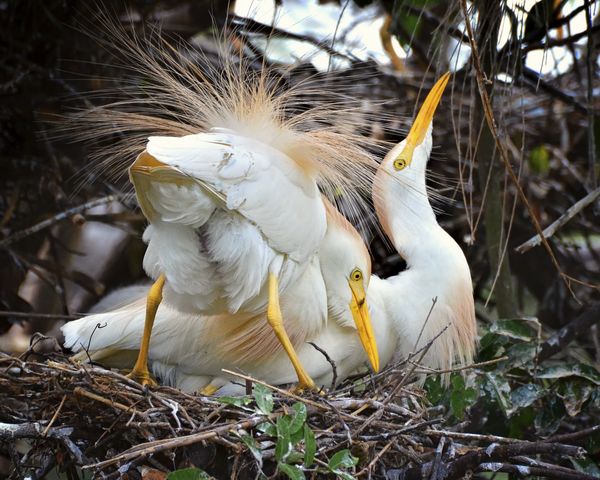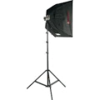Focus Issues
May 8, 2013 07:24:28 #
GoofyNewfie wrote:
Are you serious? You suggest this for someone who apparently doesn't yet understand depth of field? Chances are the OP is using a long lens to shoot the birds. The longest T/S lens Nikon makes is an 85mm and costs almost $2k. Canon's offering is quite a bit less but still only a 90mm.
This happens all the time....perfectly valid information, well meant but which would not be less understandable to the OP if it were hieroglyphics.
May 8, 2013 09:16:10 #
DPFotos
Loc: Pembroke, Ma
sportyman140 wrote:
Good morning, if you are shooting Aperture of f/2.8 then try f/5.6 or even f/8 see what happens. Also if you are photographing birds I am sure you are in SS(Shutter Speed) mode might try 1/200 or 1/250 or just a little higher number there.
you're right about stepping down the aperture, but shutter speed has nothing to do with it unless you are getting a motion blur...slower shutter will allow in more light
May 8, 2013 11:47:48 #
HEART wrote:
Sheila - some recent cheat sheets posted by a fellow hogger:
http://www.hongkiat.com/blog/cheetsheets-for-photographers/
Help they help.
http://www.hongkiat.com/blog/cheetsheets-for-photographers/
Help they help.
Great resource! Thanks.
May 8, 2013 11:54:55 #
CurreyPhoto wrote:
Lots of people at varying levels of photographic experience read these posts. I don't see any harm, and perhaps some good, in speaking not only to the presumed level of the OP but also to others, who might have more experience and can benefit from a more sophisticated answer.
True. Too much information is better than none. We, who are beginners, can take what we find useful and leave the more complicated info for the more experienced. We appreciate all the help as long as it's given without a side of sarcasm or belittling.
I find this forum a wonderful source of information for my growing love of photography.... and it's free. I will take the simple with the more complicated answers and use what I can.
May 8, 2013 12:32:25 #
rpavich wrote:
Depending on two things; you will have a "zo... (show quote)
Don't forget lens type (prime or telephoto) will also effect DoF.
May 8, 2013 14:01:29 #
strikerazde wrote:
Don't forget lens type (prime or telephoto) will also effect DoF.
How?
May 8, 2013 14:33:17 #
Relationship
What Creates Different Ranges of Focus?
1. Aperture size. Large aperture openings like f 2 or f 2.8 will have among the shortest or shallowest of range of focus. A smaller portion of the photograph is in focus when using these larger apertures. Smaller openings, like f11, f16, and f22, result in a progressively bigger depth of field, as the opening is smaller (bigger numbers = smaller openings). More of the photograph is in focus.
2. Lens type. Wide angle lenses tend to have a greater range of focus than longer telephoto lenses. The same is true even with zoom lenses. When youre zoomed to a wider angle, such as 35mm or smaller, you have a bigger depth of field than when the lens is zoomed to 100mm or higher.
3. Focal distance. This may actually be the most important setting for determining whether you have a very narrow or very wide range of focus. If the absolute focus point is set on a point less than a meter away from the camera, you will have a much shallower depth of field than if your focal point is 10 meters or more from the camera.
Consequently, although an f2.8 aperture setting where you focus on a subject less than a meter from the camera has a shallower range of focus than the same picture taken with a smaller aperture (f8, f11, f16, etc.), both images will have relatively shallow DoF precisely because the camera is focused very close. Youre likely to find that the DoF becomes narrower as you move into tighter quarters which prevent focusing on objects from a greater distance.
What Creates Different Ranges of Focus?
1. Aperture size. Large aperture openings like f 2 or f 2.8 will have among the shortest or shallowest of range of focus. A smaller portion of the photograph is in focus when using these larger apertures. Smaller openings, like f11, f16, and f22, result in a progressively bigger depth of field, as the opening is smaller (bigger numbers = smaller openings). More of the photograph is in focus.
2. Lens type. Wide angle lenses tend to have a greater range of focus than longer telephoto lenses. The same is true even with zoom lenses. When youre zoomed to a wider angle, such as 35mm or smaller, you have a bigger depth of field than when the lens is zoomed to 100mm or higher.
3. Focal distance. This may actually be the most important setting for determining whether you have a very narrow or very wide range of focus. If the absolute focus point is set on a point less than a meter away from the camera, you will have a much shallower depth of field than if your focal point is 10 meters or more from the camera.
Consequently, although an f2.8 aperture setting where you focus on a subject less than a meter from the camera has a shallower range of focus than the same picture taken with a smaller aperture (f8, f11, f16, etc.), both images will have relatively shallow DoF precisely because the camera is focused very close. Youre likely to find that the DoF becomes narrower as you move into tighter quarters which prevent focusing on objects from a greater distance.
May 8, 2013 16:15:08 #
The further you zoom the Greater the DoF.. If you have two birds sitting on a branch crank the aperture down a little and focus on the bird in front, this gives you a much better chance of capturing the bird in back. This falls under hyper focal distance. Basic understanding is 1/3 in front of focus point, 2/3 behind focus point will render acceptable focus. Here is an example shot Today. No sharpening, no PP, only cropped, Nikon 70-300mm. Used F/8 to focus on pair of birds. Focus point on bird in front..

Also used F/8 but photographed last year.

May 8, 2013 16:34:25 #
fstop22 wrote:
The further you zoom the Greater the DoF.. If you ... (show quote)
Thanks. This is really good information that I can understand.
May 9, 2013 01:09:25 #
Lucian
Loc: From Wales, living in Ohio
IF you have the time, as in the birds do not fly off, you can also (if on a tripod) focus on one, take the shot and then quickly refocus on the other and take the shot. Then put on image on top of the other and using photo shop, remove the blurred bird of one image with the sharp bird from the other, in the same image.
May 9, 2013 08:48:08 #
Lucian wrote:
IF you have the time, as in the birds do not fly off, you can also (if on a tripod) focus on one, take the shot and then quickly refocus on the other and take the shot. Then put on image on top of the other and using photo shop, remove the blurred bird of one image with the sharp bird from the other, in the same image.
Wow! Thanks.
May 10, 2013 02:16:42 #
fstop22 wrote:
The further you zoom the Greater the DoF..
I'm sorry to sound unenlightened, but I don't understand that statement. If I have a 100 - 400mm lens, do you mean that, with all else being equal (ISO, shutter speed, aperture, distance to subject), I will get a greater depth of field at 400mm than I will at 100mm.
Actually with full frame, F/8, with a subject at 300m away......
At 200mm, my DOF would be 102.78m to infinity, a virtually infinite DOF, but
If I zoom to 400mm, my DOF would be 202.79m to 576.21m, a DOF of 373.42m.
What am I doing wrong? Thank you.
May 10, 2013 09:10:10 #
GoofyNewfie wrote:
Good point! That's called the hyperfoccal distance. Basically focusing between the two objects (1/3 the way in) will help get them both in focus as you stop down.
I get what you are saying, but to someone who doesn't understand hyperfocal distance, this could create a mess. If there is sky between the 2 birds, and you focus between them, you aren't going to get either bird in focus. You need to focus on a branch or something between the 2 birds, not just in the space between the 2 birds.
No offense Goofy, just wanted to clear up your point just a bit for any newbies.
May 10, 2013 09:30:04 #
bkyser wrote:
I get what you are saying, but to someone who doesn't understand hyperfocal distance, this could create a mess. If there is sky between the 2 birds, and you focus between them, you aren't going to get either bird in focus. You need to focus on a branch or something between the 2 birds, not just in the space between the 2 birds.
No offense Goofy, just wanted to clear up your point just a bit for any newbies.
No offense Goofy, just wanted to clear up your point just a bit for any newbies.
I understand the point you are making. No offense taken.
There may not be anything to focus on between the closest object and the farthest one. It's not always easy to do. Shoot several and "bracket" focus...or just scare one away, leaving only one to worry about.
May 10, 2013 10:54:15 #
GoofyNewfie wrote:
I understand the point you are making. No offense taken.
There may not be anything to focus on between the closest object and the farthest one. It's not always easy to do. Shoot several and "bracket" focus...or just scare one away, leaving only one to worry about.
There may not be anything to focus on between the closest object and the farthest one. It's not always easy to do. Shoot several and "bracket" focus...or just scare one away, leaving only one to worry about.
"...scare one away..." Ha, ha! "I'm sorry guys, but one of you is going to have to leave. I can't focus on both of you."
I like the idea of "bracket" focus. :thumbup:
If you want to reply, then register here. Registration is free and your account is created instantly, so you can post right away.









